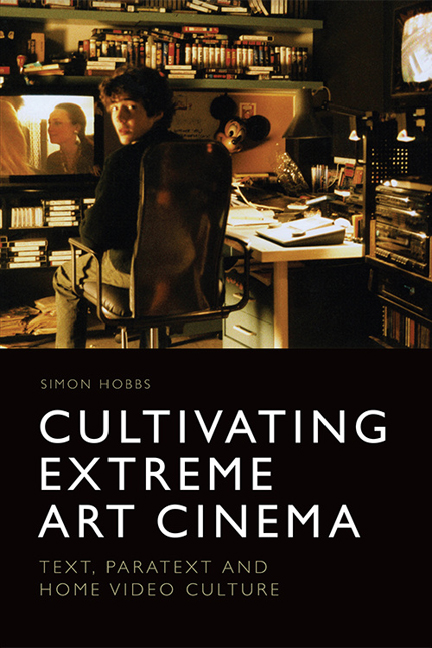Book contents
- Frontmatter
- Contents
- List of Figures
- Acknowledgements
- 1 Introduction
- 2 Art and Exploitation: Crossover, Slippage and Fluidity
- 3 Early Extremity on DVD: History, Precursors and Exploitation Auteurs
- 4 Weekend and Cannibal Holocaust: Art, Ballyhoo and Remediation
- 5 Salò, Or the 120 Days of Sodom and Ilsa, the Wicked Warden: Fascism, Pornography and Disgust
- 6 Contemporary Extremity on DVD: Trends, Hard-core and Geographic Mobility
- 7 Michael Haneke: Glaciation, Legitimacy and Transgression
- 8 Lars von Trier: Provocation, Condemnation and Confrontation
- 9 Conclusion
- Bibliography
- Index
2 - Art and Exploitation: Crossover, Slippage and Fluidity
Published online by Cambridge University Press: 28 April 2021
- Frontmatter
- Contents
- List of Figures
- Acknowledgements
- 1 Introduction
- 2 Art and Exploitation: Crossover, Slippage and Fluidity
- 3 Early Extremity on DVD: History, Precursors and Exploitation Auteurs
- 4 Weekend and Cannibal Holocaust: Art, Ballyhoo and Remediation
- 5 Salò, Or the 120 Days of Sodom and Ilsa, the Wicked Warden: Fascism, Pornography and Disgust
- 6 Contemporary Extremity on DVD: Trends, Hard-core and Geographic Mobility
- 7 Michael Haneke: Glaciation, Legitimacy and Transgression
- 8 Lars von Trier: Provocation, Condemnation and Confrontation
- 9 Conclusion
- Bibliography
- Index
Summary
Although society is relying increasingly on digitalised content, and the dominance of streaming sites such as Netflix and Amazon Prime are changing the ways in which audiences consume media, it would be premature to suggest that people have moved on from physicality completely. Certainly, the types of collections people maintain will change, becoming virtual as they move from shelves to hard drives and ‘clouds’. However, media culture is in a transitional period, as film and television find themselves spread across multiple platforms, with audiences jumping between tangible consumption and streaming platforms at will. This changing landscape is influencing the types of media object produced, as some distributors are seemingly placing a higher value on the paratextual artefact and its innate tangibility. More than ever, distributors are releasing special editions with countless featurettes and new content, or offering bespoke packaging designs which increase the products’ collectability. Granted, this may be short-lived, and as will be discussed later, could represent something of a ‘last hurrah’ for the DVD/Blu-ray market. Nonetheless, it is these special editions, these added extras – and their almost exclusive connection to the tangible format – that allows us to assess the ‘lives’ extreme art films lead in the public and market sphere.
My centralisation of the object is best framed through a discussion of material culture, which ‘emphasises how apparently inanimate things within the environment act on people, and are acted upon by people, for the purposes of carrying out social functions, regulating social relations and giving symbolic meaning to human activity’ (Woodward 2007: 3). For Ian Woodward, objects ‘assist in forming or negating interpersonal and group attachments, mediating the formation of self-identity and esteem, and integrating and differentiating social groups, classes and tribes’ (Woodward 2007: 4). Consequently, the object takes on additional meaning beyond its original purpose, either to a group or individual, and enjoys a ‘social life’ in which its meaning, relevance and status can change (Woodward 2007: 29). The DVD/Blu-ray object leads several social lives, as it can inform a collector's sense of identity, establish and increase cultural capital, and alter an audience's relationship to the text. It is the latter that is important to my work and will remain a key focal point throughout the book.
- Type
- Chapter
- Information
- Cultivating Extreme Art CinemaText, Paratext and Home Video Culture, pp. 18 - 40Publisher: Edinburgh University PressPrint publication year: 2018



